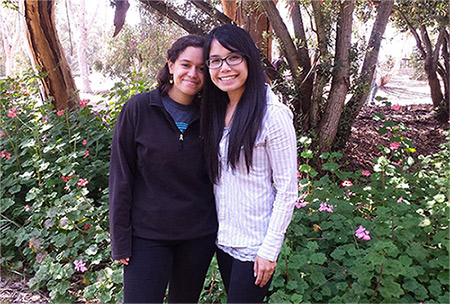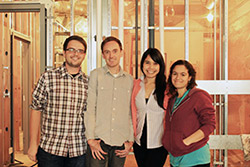TDLC Comes Full Circle:
The delicate balance of mentoring someone is not creating them in your own image,
but giving them the opportunity to create themselves.
 — Steven Spielberg
— Steven Spielberg
The Temporal Dynamics of Learning Center (TDLC) has always valued mentorship and collaboration. From the start, a large part of the TDLC community has included trainees: More than 150 students have participated in Center laboratories across 18 research institutions in four countries (U.S., Canada, England, and Australia)! Through mentorships with TDLC Investigators, students have learned tools and techniques, gained invaluable research experience, and perhaps most importantly, become members of a scientific community that is open to sharing research and ideas. An example of this mentoring is the collaboration between Dr. Andrea Chiba, former trainee Dr. Lara Rangel (below, right), and current student Pamela Rivière (below, left).

From TDLC Trainee to TDLC Mentor
San Francisco born Lara Rangel was raised in the TDLC. Before receiving her B.S. at Stanford University in 2006, she participated in a summer program called the UC San Diego Summer Training Academy for Research Success (or Stars) program. There, she met Dr. Andrea Chiba and was immediately captivated – not only by Andrea’s research, but by her ability to see connections between research, as well as her ability to inspire and mentor students. Andrea fostered creative exploration and let Lara “grow into her own way of thinking” rather than trying to shape Lara into her own image.
“Everyone in the Chiba lab was treated like a colleague, even if you were an undergraduate. I was always sitting at the ‘big table’ and treated as if I was a growing expert, and that my opinion and my ideas really mattered,” Lara explains, exuding a warmth reminiscent of her mentor. “Andrea guided me, yet at the same time, let me grow and learn it on my own so that I was able to feel like it was my own growth and my own ideas. There is something very unique about that.”
Lara was so inspired by this experience that she applied, and was accepted to, the UC San Diego Neurosciences Graduate Program in 2006. She became a TDLC trainee during the initial year of the Center – attending the first ever TDLC All Hands Meeting, and even presenting a poster at the event. The collaborative structure of the Center enabled her to construct a project that bridged the interests of two center labs.
“I completed a rotation in Dr. Rusty Gage’s lab,” she explains. “He was doing beautiful research with adult neurogenesis that was ripe for a behavioral neurophysiology collaboration.” She continues, “When I talked to Andrea about it, she said that the collaborative community was already in place to support my work. So I had two advisors – Rusty Gage and Andrea Chiba.” During this experience, Lara was especially struck by Andrea’s ability to see the threads between researchers. “She can see when people have the potential to be the glue or the bridge,” Lara affirms, “and she knows how to make it happen.”
 Under the mentorship of Andrea and the TDLC (from 2006-2011), Lara gained confidence, invaluable experience, and excitement about her ability to develop new ideas and research. In 2015, Lara became a UC Chancellor’s Postdoctoral Fellow at UC San Diego, an Assistant Professor in the Department of Cognitive Science, and currently Principal Investigator (PI) in the Neural Crossroads Laboratory. There, she studies the hippocampus and hopes to provide new insight into the single cell interactions underlying the occurrence of brain rhythms measured in rodents and humans. (Photo: Lab members Teryn, Jerry, Lara, and Pam. Credit: Neural Crossroads Laboratory)
Under the mentorship of Andrea and the TDLC (from 2006-2011), Lara gained confidence, invaluable experience, and excitement about her ability to develop new ideas and research. In 2015, Lara became a UC Chancellor’s Postdoctoral Fellow at UC San Diego, an Assistant Professor in the Department of Cognitive Science, and currently Principal Investigator (PI) in the Neural Crossroads Laboratory. There, she studies the hippocampus and hopes to provide new insight into the single cell interactions underlying the occurrence of brain rhythms measured in rodents and humans. (Photo: Lab members Teryn, Jerry, Lara, and Pam. Credit: Neural Crossroads Laboratory)
Trainee Becomes the Trainer
In 2017, Cognitive Science graduate student Pamela Rivière joined the Neural Crossroads lab to work with Lara Rangel. Lara was familiar with Pam, having worked together in the same lab in Boston. Because Lara had such a positive experience in her mentorship with Andrea, she is determined to be as equally inspiring a mentor to Pam.
The two share very similar research interests. Like Lara, Pam is interested in studying neural activity in the hippocampus. “We look at associative memory types of behaviors. For example, a rat might encounter an object for the first time,” Pam describes. “The rat then pushes the object over, and lo and behold there’s a treat under there! So when he sees that object the next time around, he’s going to be more willing to approach it because he has had an experience with a reward. He knows that object is something good.” She continues, “We look at how neural activity is recruited while a rat is learning these sorts of associations. How does the brain become engaged? We look at two sub-regions of the hippocampus called the dentate gyrus and the CA3 region. How are these two sub-regions temporally coordinating their activities?”
“It’s a super temporal dynamics of learning center project!” Lara points out, laughing.
Lara and Pam plan to pilot the project this year, and Pam will present a talk to her department next quarter to discuss preliminary findings. Like Lara, Pam has found the Chiba lab to be very team-oriented and inclusive. “It’s like a lab suite instead of just a lab silo,” Pam says, describing the layout of the side-to-side labs. The close proximity and team environment offers a huge benefit: “I receive a lot of mentorship from the investigators!”
Another form of support Pam has received has been financial. Andrea encouraged Pam to apply for one of two San Diego Fellowships that TDLC offers annually. Pam won the fellowship, and happens to be its final recipient, receiving the fellowship from Fall 2017 through June 2018. This award has been extremely beneficial, enabling Pam to focus on getting her research project started, instead of having to worry about finances and balancing another job.
The Future
Lara and Pam admit that their paths haven’t always been easy. For example, both have struggled to navigate workload and career pressures that are all-too-common in competitive lab environments. During these struggles, just knowing that the TDLC model exists has given them both confidence.
“I always say that the TDLC is a template for how science can be done, and that has helped me navigate situations elsewhere,” Lara shares. She warns that TDLC trainees might feel ‘culture shock’ when they graduate and realize that in other research environments, the way people perform science may be very different and competitive. But she hopes that the template of a scientist continues to evolve so that mentorship, open collaboration, and sharing of ideas becomes the norm.
Andrea adds, “The general scientific climate is so competitive these days that it is really wonderful that there are still high-level research scientists who are willing to slow down and devote large chunks of time towards teaching aspiring scientists the intricacies of research. It is a labor of love, not just for the students, but also for the future quality of the larger scientific community."
In the field of scientific research, Lara and Pam will continue to face challenges – such as balancing their laboratory research projects while teaching classes and continuing to search for funding. But despite the challenges, their futures seem bright. Now that Lara has a lab of her own, she is more determined than ever to build her own community. She uses TDLC, and Andrea specifically, as a working model and her inspiration. Through her mentorship, she has learned tools to navigate the road ahead -- tools like knowing how to create trusting relationships, building and leading a team, and being able to see the threads between people and research.
In a similar way, Pam finds strength in her mentorship under Lara’s guidance. She recently submitted a paper that is soon-to-be published, she won an NSF Graduate Research Fellowship this year, and to the relief of both Lara and Pam, they both received high marks on their recent teacher evaluations.
TDLC Coming to a Close
While TDLC’s NSF funding is ending this year, the Center has enjoyed over a decade of success. There is growing attention to this new paradigm shift in learning, with the USA, Australia, China, Latin America, and Europe showing interest in creating a Global Science of Learning Movement. And although the TDLC is winding down, its members have seen what can be accomplished using a collaborative and interdisciplinary research model. The relationships and tools they have established at the Center will continue to exist and grow. Lara concludes, “The TDLC is full of people who see the connections, the bridges between labs and the advances that can be made when we can get certain groups working together on the same project. Then they raised a group of students, like me, who have research that is bridge work, the sort of stuff that is right in the center of interdisciplinary. I think science really needs bridge work right now, and the TDLC is full of visionaries for this exact thing.”
As the TDLC sunsets, it is especially fitting that the Center’s final San Diego Fellow, Pamela Rivière, has received an NSF Graduate Research Fellowship to work with former TDLC fellow Lara Rangel. This cycle of mentorship is an example of the TDLC coming full circle. As Andrea Chiba affirms, "What a gratifying way to bring the TDLC NSF funding to a close!"
![]() R. Weistrop (June 2018)
R. Weistrop (June 2018)
Note: TDLC has also offered a summer Internship program for high school, undergraduate and graduate research and training.